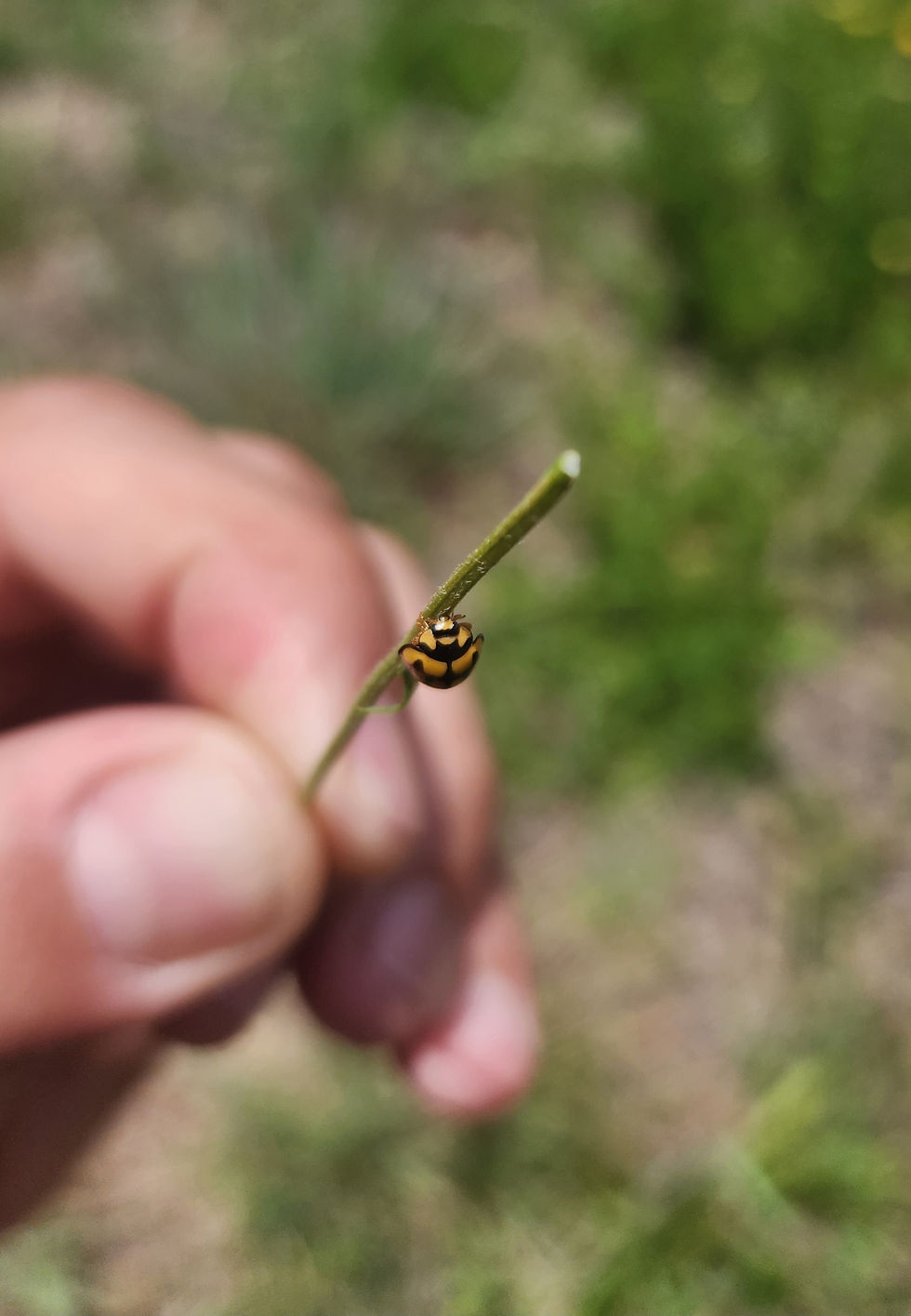The Lunate Ladybeetle
When you think of ladybirds, you might picture the classic red beetle with black spots, happily wandering across the leaves of your garden plants.
But did you know that the name “ladybird” has a deeper historical significance? The term “lady” in ladybird or ladybug refers to the Virgin Mary.
During medieval times in Europe, farmers would pray to the Virgin Mary when pests were threatening their crops.
Incredibly, when a small army of colorful beetles arrived to feast on these pests, the crops were saved. This divine intervention led to the ladybird being named in her honor.

A Brief History and Cultural Significance of Ladybirds
The Lunate Ladybeetle, Cheilomenes lunata, is a distinctive species found in South Africa, where it’s becoming more common.
It’s part of a larger family of ladybirds, which includes many species across the globe. While most people may associate ladybirds with the classic red-and-black variety, some, like the Lunate Ladybeetle, stand out with their shiny yellow or orange bodies.
Interestingly, in Belgium and Flanders, the ladybird is referred to as “Lievenheerbeesje”, or “the Lord’s little beast”, and is protected by law, making it illegal to harm them or even collect their eggs.
The Netherlands also considers the ladybird a symbol against senseless violence, showcasing how these tiny creatures have earned a place in folklore and modern-day environmental advocacy.
A Key Player in Pest Control
This cheerful-looking beetle is a powerful ally in the garden. With its medium-sized body of about 8 mm, the Lunate Ladybeetle stands out with its warm yellow to orange color.
But more importantly, these ladybirds are efficient predators of some of the most common garden pests. Their main diet consists of aphids, mealybugs, and other soft-bodied pests that damage plants.
Particularly, the Lunate Ladybeetle is especially effective against wheat aphids, making it a useful tool in agricultural pest control.
When the eggs of these ladybirds hatch, the larvae immediately begin feeding. In fact, the young larvae will often consume the egg itself as their first meal, ensuring that these beetles have a quick start in life.
As they grow, they continue their feast, devouring hundreds of aphids and other pests, making them a gardener’s best friend.

The Science of Ladybeetles
Ladybirds are often mistakenly referred to as “ladybugs”, but they are not actually true bugs. The term “bug” is reserved for insects in the Hemiptera family, which have half-hardened, half-membranous wings.
In contrast, ladybeetles belong to the Coleoptera order, and their forewings are entirely hardened. These elytra protect their membranous hind wings, which are used for flight.
While ladybirds may have earned a reputation as the ultimate pest controllers, it's important to remember that not all ladybird species are harmless.
Some invasive species, though they are beneficial in many cases, can still cause harm to certain crops.
The Fascinating Life Cycle of a Ladybeetle
Ladybeetles, like all beetles, undergo metamorphosis in four distinct stages: egg, larva, pupa, and adult.
The life cycle begins when the ladybird lays its eggs on a plant that is home to its future food sources. When the larvae hatch, they immediately begin consuming aphids, mealybugs, and other pests.
The larvae grow for about a month before pupating, eventually emerging as the bright, adult ladybird we recognize.
Their ability to rapidly consume large quantities of pests during their larval stage makes them particularly valuable to gardeners.
In fact, some ladybird species were even imported to the United States from Australia in the 19th century to protect orange orchards from aphid infestations.
Toxins for Protection
While ladybeetles are beneficial to humans, they also have their own defenses. If they feel threatened by a predator, such as a bird or a cat, they secrete a yellowish toxin from the joints of their exoskeleton.
This chemical, which is harmless to humans, serves to deter predators, making the ladybird an unappetizing meal. It’s an example of how these seemingly delicate creatures are equipped with the tools to protect themselves in the wild.

A Garden’s Best Friend
Ladybeetles, especially the Lunate Ladybeetle, are far more than just pretty insects to admire. These fascinating creatures play a vital role in maintaining healthy ecosystems and helping gardeners keep pests at bay.
By eating aphids and other harmful pests, they naturally reduce the need for chemical pesticides, making them a safer and more eco-friendly option for managing garden pests.
About The Author
Kyle Grobler is a passionate environmentalist and esteemed field guide from Potchefstroom. With an unparalleled love for nature, he boasts a vast collection of over 40,000 photos, illustrating his particular affinity for birds.
Known by many as the embodiment of a true bushman, Kyle has ventured through various South African game reserves and frequently explores the Vaal River's hidden treasures. As a new contributor to the Potch Gazette's environmental page, readers can anticipate immersive tales of Potchefstroom's natural wonders through Kyle's expert lens.
To see more from Kyle and his bush experiences you can also view his Youtube Channel here: Kyle Grobler Photography
More Insect Stories
For more articles about insects you can click on the links below, there are so many great insects living amongst us to discover and learn about as they play a major role in nature as we see it today.
Dung Beetles: Click Here
Eastern Dotted Border: Click Here
Elegant Grasshopper: Click Here
Brown - Veined White: Click Here
Millipede Assassin Bug: Click Here
Acacia Bagworm: Click Here
African Moon Moth: Click Here
CMR Blister Beetle: Click Here
Tent Caterpillar: Click Here
Red - Veined Dropwing: Click Here
Milkweed Locust: Click Here
Common Tigertail: Click Here
African Honeybee: Click Here
Giant African Mantis: Click Here
Common Diadem: Click Here
Spotty Conehead Mantid: Click Here
Koppie Foam Grasshopper: Click Here
Painted Lady: Click Here
African Giant Millipede: Click Here
Zebra Millipede: Click Here
Foxy Emperor: Click Here
Needle Waisted Paper Wasp: Click Here
Turquoise Longhorn Beetle: Click Here
Predatory Katydid: Click Here
White - Barred Acraea: Click Here
Sun Spider: Click Here
Processionary Caterpillars: Click Here
Spotted Joker: Click Here
African Black Beetle: Click Here
Comments, Suggestions, Stories
Please do feel free to add any comment



.jpeg)
